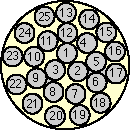|
See also 68-Conductor SCSI Pinout for SE and HVD Interface
See also 68-Conductor SCSI Pinout for LVD/MSE SCSI
| PIN# |
CABLE
PAIR |
SINGLE
ENDED
Signal Name |
DIFFER-
ENTIAL
Signal Name
|
| 1 |
13 |
GROUND |
GROUND
|
| 2 |
14 |
GROUND |
+DB0
|
| 3 |
15 |
GROUND |
+DB1
|
| 4 |
16 |
GROUND |
+DB2
|
| 5 |
17 |
GROUND |
+DB3
|
| 6 |
18 |
GROUND |
+DB4
|
| 7 |
19 |
GROUND |
+DB5
|
| 8 |
20 |
GROUND |
+DB6
|
| 9 |
21 |
GROUND |
+DB7
|
| 10 |
22 |
GROUND |
+PARITY
|
| 11 |
23 |
GROUND |
DIFFSENSE
|
| 12 |
24 |
RESERVED |
RESERVED
|
| 13 |
25 |
OPEN |
TERMPWR
|
| 14 |
11 |
RESERVED |
RESERVED
|
| 15 |
12 |
GROUND |
+ATN
|
| 16 |
3 |
GROUND |
GROUND
|
| 17 |
4 |
GROUND |
+BSY
|
| 18 |
5 |
GROUND |
+ACK
|
| 19 |
2 |
GROUND |
+RST
|
| 20 |
6 |
GROUND |
+MSG
|
| 21 |
7 |
GROUND |
+SEL
|
| 22 |
8 |
GROUND |
+C/D
|
| 23 |
9 |
GROUND |
+REQ
|
| 24 |
1 |
GROUND |
+I/O
|
| 25 |
10 |
GROUND |
GROUND
|
|
| PIN # |
CABLE
PAIR |
SINGLE
ENDED
Signal Name |
DIFFER-
ENTIAL
Signal Name
|
| 26 |
13 |
-DB0 |
GROUND
|
| 27 |
14 |
-DB1 |
-DB0
|
| 28 |
15 |
-DB2 |
-DB1
|
| 29 |
16 |
-DB3 |
-DB2
|
| 30 |
17 |
-DB4 |
-DB3
|
| 31 |
18 |
-DB5 |
-DB4
|
| 32 |
19 |
-DB6 |
-DB5
|
| 33 |
20 |
-DB7 |
-DB6
|
| 34 |
21 |
-PARITY |
-DB7
|
| 35 |
22 |
GROUND |
-PARITY
|
| 36 |
23 |
GROUND |
GROUND
|
| 37 |
24 |
RESERVED |
RESERVED
|
| 38 |
25 |
TERMPWR |
TERMPWR
|
| 39 |
11 |
RESERVED |
RESERVED
|
| 40 |
12 |
GROUND |
-ATN
|
| 41 |
3 |
-ATN |
GROUND
|
| 42 |
4 |
GROUND |
-BSY
|
| 43 |
5 |
-BSY |
-ACK
|
| 44 |
2 |
-ACK |
-RST
|
| 45 |
6 |
-RST |
-MSG
|
| 46 |
7 |
-MSG |
-SEL
|
| 47 |
8 |
-SEL |
-C/D
|
| 48 |
9 |
-C/D |
-REQ
|
| 49 |
1 |
-REQ |
-I/O
|
| 50 |
10 |
-I/O |
GROUND
|
|
For more detailed information on SCSI cabling including connector types, see:
- SCSI Quiet Cable™
The secret of SCSI Quiet Cable is that they are built according to the SCSI specification, consisting of 25 or 34 twisted pairs of multi-stranded 28-gauge flexible copper wires.
For an overview of SCSI cabling, see:
And for information on how to verify SCSI cable performance, see:
- Cable Cautions
SCSI whitepaper detailing the need to build SCSI cabling to the correct SCSI specifications.
And for information on how to verify SCSI cable performance, see:
|




